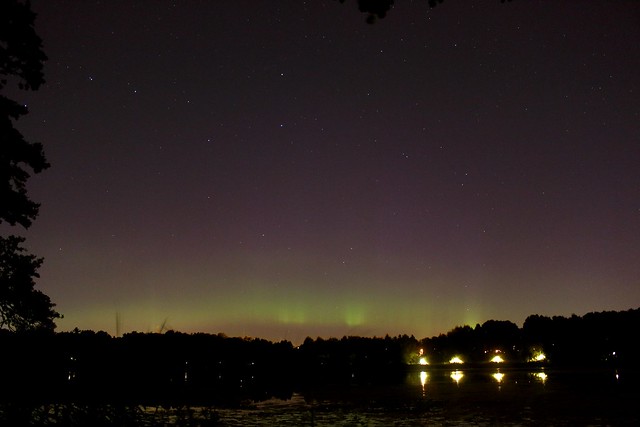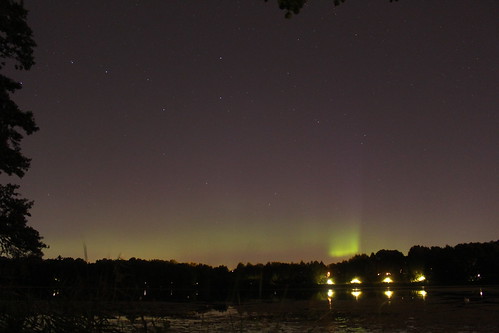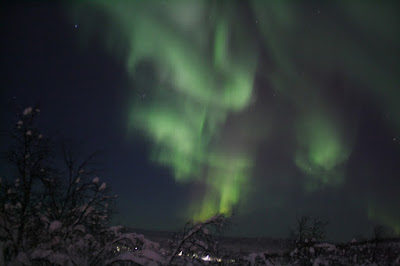This will be a very long post about how to do your best to have the chance to see the northern lights. And, although it is unintended, that will start testing the most needed skill to see the northern lights: patience.
I included "in Stockholm" in the title because it is where I live, it has some special challenges to see the aurora borealis here and this is intended for some friends living in this area. The title could have been "how to see the northern lights for dummies" but that thing for dummies is a trademark.
I am trying to use plain language and avoid technical jargon. In fact I am not an expert but only amateur in this field. These recommendations could be also useful for the southern lights or aurora australis.
I am going to talk about:
1. What are the northern lights or aurora borealis: the fox, the sun and the magnetic field
2. How to prepare yourself for aurora hunting: take care of yourself
3. Where to be to have the largest chance to see them
Maybe in a further post I will talk something about how to photograph the aurora borealis, from my amateur experience and trying to translate jargon into a language that any people with a camera can understand. All aurora pictures are mine.
What are the northern lights
In Finnish, the name for the aurora borealis is "Revontulet", which literally translated means "Fox Fires." The name comes from an ancient Finnish myth, a beast fable, in which the lights were caused by a magical fox sweeping his tail across the snow spraying it up into the sky (1). I prefer this version to the one that says something that electrons from the sun causes the auroras when directed to the poles by the earth's magnetic field.
According to the scientists from the Space Weather Prediction Center at National Oceanic and Atmospheric Administration of the USA...
"The Aurora Borealis (Northern Lights) and Aurora Australis (Southern Lights) are the result of electrons colliding with the upper reaches of Earth’s atmosphere. The electrons are energized through acceleration processes in the downwind tail (night side) of the magnetosphere and at lower altitudes along auroral field lines. The accelerated electrons follow the magnetic field of Earth down to the Polar Regions where they collide with oxygen and nitrogen atoms and molecules in Earth’s upper atmosphere. In these collisions, the electrons transfer their energy to the atmosphere thus exciting the atoms and molecules to higher energy states. When they relax back down to lower energy states, they release their energy in the form of light. This is similar to how a neon light works. The aurora typically forms 80 to 500 km above Earth’s surface."(2)
Those electrons are brought to the earth mainly by solar storms but also by the solar wind (permanent but not able to create auroras but in specific circumstances). In summary electrons from the sun causes the auroras after interacting with the magnetic field. This is important because the magnetic field is shaped on the two magnetic poles that do not coincide with the geographic poles. And that is why auroras are not equally distributed when they occur. You can see in the pictures below how the aurora oval is not centered to the geographic pole but leaned to North America for the northern hemisphere and to Australia and New Zealand for the southern hemisphere (3).
In the link of the reference 2 you can find more info on this if you want to deepen in the details.
And what is the aurora oval?
Is the zone where the electrons from the sun, driven by the magnetic field, collide with atoms in the atmosphere creating the aurora. The auroral ovals enlarge during high solar activity and displays are then visible further south in England, Germany and mid latitude USA. Solar disturbances take 2-3 days to reach Earth and aurorae are therefore to some extent predictable. (4)
Why the aurora can have different colors?
The electrons can interact with Oxygen, in different ways and with Nitrogen causing different colors. Green is the most common color seen in auroras, followed by red, much less common, and by purple blue, which is infrequent. This interaction occurs always 100 km or higher above the surface of the earth.
How to prepare yourself?
Two words summarize this: patience and information. But I can also add the first of all you need to take care of yourself.
Given that I am writing this for people living in Stockholm, I can assume that you are not going to travel so much from that city. But if you are planning to go to a northern place to hunt auroras, you will find useful to consider going in a dark time (winter) that means it will be cold or extremely cold. And maybe the surface will be slippery and as you need an open space you could not have a source of heat very near. And it will be dark. And you would be outside long times, not common in winter time challenging your usual winter clothing warming capabilities. It all depends on the place you go and the time of the year but I recommend be extremely cautious in your safety measures. You must avoid frostbite, drowning in a partially frozen lake, hurt your body in a fall, etc. Ask the locals and also ask somebody that had visited the place in that time of the year to get advice. Take care of yourself.
Auroras are a magnificent show but it is not like a waterfall that it is always in the same place and, given the data on rains or drought, you can expect more or less water. You can even make a phone call or write an email or check the web to know how the waterfall is in a specific moment. Sadly, that does not happen with auroras so you need to be extremely patient and most of the time, lucky. So, if you know where to find patience or luck go and buy some right before hunting auroras.
The only thing we can do is to be informed. There are plenty of information sources on solar activity and aurora forecast. But most, if not all of them, are based in information from NOAA. The NOAA's Space Weather and Prediction Center has a permanent informaton system on aurora activity, Kp index, aurora oval, solar storms, etc. Sometimes is a little bit confusing and I will try to explain my interpretation on its data.
My main source of information is the 30 minutes aurora forecast page. There you can see two maps, southern and northern hemispheres and their aurora ovals. You will see in the right top corner the time the forecast is for. Note that the stated time is set to Universal Time (UT), London time without any seasonal adjustment. Right now, summer in Stockholm, my clock are two hours ahead of UT. In winter time will be only one but it will never be the same.
In those maps you will see the forecasted aurora oval for 30 minutes later or so. The image changes in color and size of the oval according to the forecasted auroral activity. During the geomagnetic storm of March 17 2015, St Patrick's storm, we got images like this, and even stronger (3):
It is really uncommon to see ovals with that amount of red and going that far south. Actually, in that night there were reported of auroras sight from northern Germany, and Arizona, in the United States. The geomagnetic storm of that day was the strongest in several years (in the current solar cycle but it is not necessary to explain more and complicate the story in this post).
One important data from this image, for me, is the hemispheric power. When it is above of 45 GW I have noticed that I have chance to see the aurora in Stockholm. So if you want to check quickly if you will be able to see the northern lights, go to this place and check the oval and the hemispheric power. In the St Patrick's storm we got hemispheric values above 120 GW
There is another measure of the strength of the geomagnetic storm and, actually, it is the standard to define if the activity reached the category of storm and if it is the Kp Index. It is a simple index from 0 to 9. If the value is above 5 you have a geomagnetic Storm and you can expect some auroral activity in the Stockholm skies. You can see which is the Kp index needed to see auroras in specific places according with magnetic latitudes. You can also find the way to know the magnetic latitude of your place (that latitude related to magnetic pole and not to geographic ones).
The thing with Kp is that there is no an easily available current value or a short term forecast as it is for the hemispheric power. But you can suscribe to different alert services, all based in the Kp value. One of those, is free and by email, is available here. When logged in, select the category Geomagnetic storms and there select the one that you think is interesting or valuable. But be careful! It can be a lot of emails and you will, at the end, delete them without reading and you will miss the chance of being informed of an stunning show. Most of the people in Stockholm did not know of the St Patricks Storm and only was aware the following day, too late.
Now that you see that it is possible that an auroral show is in Stockholm you need to load yourself with patience and endurance and go into the wild!
How to see the auora borealis
First of all it must be night (of course) and you need clear skies and preferable no moon but this one could not be as frustrating as having a thick grey cloud between you and the aurora. That is something quite common during the winter in this city.
Another characteristic of this city it is south enough to have a low possibility to see the northern lights. For most of the world Stockholm is up north but for these matters it is down south (Down under?).
Knowinf those limitations, let's continue. As the NOAA says, the most important thing is location, location, location. In general the northest you are situated, the more likely to see the auroras you are. But, a huge but, it is here when the magnetic poles become important. The aurora oval are more or less centered to the magnetic poles and that means that the ovals go farthest to the south in America than in Asia or Europe. That means that for the same conditions (mainly solar activity) and having an oval of the same size, auroras can be seen in a more southern latitude in America than in Europe. But not being so far, there could be also a big difference between Stockholm, in Sweden, and Bergen, in Norway. Those cities are almost at the same latitude (distance to equator and the north pole) and given the position of the oval it is much more likely to see auroras in Bergen than in Stockholm. So, if you want to see the auroras and you do not want so go that far north, it would be, apparently, better to go to Norway.
But we are in Stockholm, remember? And supposing we are lucky enough of having clear skies, now we need to go to a dark place with a wide view to the north. The view near my house has a small pond between me and some tall trees 300 m towards the north and it is very wide, around 500 m to the right and to the left. It was quite enough to see the northern lights last time. But it woukd be better to go to places like Monteliusvägen or Skinnarviksberget in Södermalm that are dark and on a hill. The disadvantage of going there is that you will have the lights of Kungsholmen and the city in front of you, even if the places themselves are dark. The place near my home is quite dark but not totally. There are some street lights that can cause some inconveniences. I think there are many places in the northern side of Södermalm that could be interesting, also Haga Parken could have several more. I have not tried other but my neighborhood.
Even if you find the dark place with a huge view to the northern sky, just remember that you are in the city and the lights from it create a glow that limits the possibility of seeing faint sky objects as many stars and, of course, aurora borealis. If you are adventurous and have means of transportation (and do not need to wake up early the following day) you can try to find a dark place outside of the city, with a great view to the north. But remember, the lady with the green veils (or red or purple) could not show up despite the forecasts.
Several sites report that the aurora is more active and easy to find in the last three hour before midnight but they can appear at any moment when it is dark. Here in Stockholm I have seen them at midnight or later. But In Kiruna I saw them at 8 PM in the most fascinating show I have had so far (not so many, I have to acknowledge). I also saw them after 11 PM in another two opportunities there.
Did I tell you about assuring your safety and security? Currently, summer in Stockholm, the weather is great but we do not even have 3 hours of total darkness (changing very quickly, I have to say). The darkness of winter brings also the risks of standing outside in the cold for long times and increases the risk for other kind of accidents. Take care of yourself and your friends.
If you want to know when it is really dark in your city go to www.timeanddate.com, look for your city and check the time that starts and ends the Nautical Twilight. It is not the time of total darkeness but is quite close. The civil twilight, the sunrise and sunset does not define total darkness, only some stages of the sun below the horizon.
Everything seems ready. Now go outside and look for the aurora. It could take several hours or a couple of minutes, who knows, to see it. Or maybe the lady never appears. Here is when the patience you loaded starts working.
Keep in the darkness, and your eyes will be accustomed to that. Do not play with your phone. But if you really need to use it, for instance to check the aurora oval, change in advance the screen brightness to the minimum and limit the time you check it. Be sure also that you have enough battery or a portable charger in order to make an emergency call or to text somebody that the aurora show already begun. It would be also recommendable have some snacks and sweet things at hand.
Try not to be alone and that the company is funny or interesting. Standing outside a couple of hours without more distraction the looking to the north in the darkness could be overwhelming for some people.
If you plan to take pictures, my only recommendation here is: not be distracted trying to adjust your camera. Enjoy the show with your own eyes. It could be very short. And remember that almost all the pictures you can find have some kind of enhancement to make colors more vibrant. Don't be sad if you do not get the same results in the first try. Step by step I have been improving but far from being experienced.
Don't forget, either, that the camera is more sensitive than your eye and can catch thigs you don't. So, don't feel bad if after the show you find that someone else's picture show thing you did not catch.
More details on the interaction of electrons and atmosphere in reference (6)
More details in how the colors are created by different kind of interaction of the electros in reference (7)
(1) http://www.luminarium.org/mythology/revontulet.htm
(2) http://www.swpc.noaa.gov/phenomena/aurora
(3) http://www.swpc.noaa.gov/products/aurora-30-minute-forecast
(4) Info on Kiruna magnetometer in Spaceweather live
(5) http://www.atoptics.co.uk/highsky/auror1.htm
(6) http://www.atoptics.co.uk/highsky/auror2.htm
(7) http://www.atoptics.co.uk/highsky/auror3.htm
Additional resources on aurora forecast (and other interesting phenomena)
http://www.spaceweather.com/
http://www.spaceweatherlive.com/en
http://www.aurora-service.eu/
------
Deficient pictures of the St Patrick's storm over Stockholm. You cannot see details but you can have an idea on how strong it was
Update, On October 7 2015 there was a wonderful show over Stockholm. Here some pictures
















Comentarios